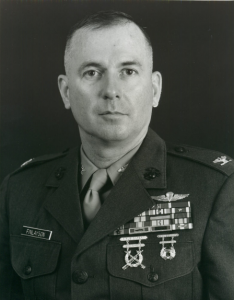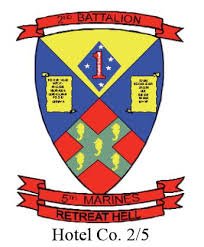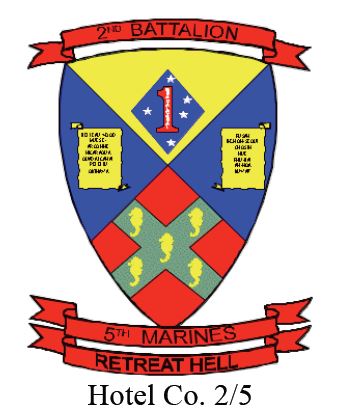The Strategic Importance of An Hoa Combat Base
 By Colonel Andrew R. Finlayson, USMC (Ret.)
By Colonel Andrew R. Finlayson, USMC (Ret.)
For most US Marines who lived in, or fought near it, the An Hoa Combat Base (CB) was just a place they found themselves in while they fought their war against the North Vietnamese Army’s (NVA) 2nd Division and local VC units. Its strategic significance was little known or understood by the Marines who fought to protect it. Most Marines lived day to day, fighting to stay alive and to keep the enemy from overrunning that particular piece of real estate in Quang Nam Province, South Vietnam; They gave little thought as to why the enemy was so intent upon trying to control the territory in its immediate vicinity. I hope this short paper will help to explain how the base was viewed by the North Vietnamese Army in the context of their overall strategy for the war and to give the Marines who were based at An Hoa CB a better understanding of why they were there.
To understand the base’s importance, it is essential to understand the enemy’s overall strategy and its influence on Quang Nam Province. The communist leadership in Hanoi decided in May 1959 to overthrow the South Vietnamese government (GVN) by force and began to plan for the eventual invasion of South Vietnam using conventional, mobile NVA units. To prepare the way for this eventual conventional attack, they began sending political cadres south to assist local communist cadres in a massive effort to organize the rural population of South Vietnam under the leadership of the communist party (the Lao Dong Party). Once they had organized large areas of South Vietnam, they initiated a guerrilla campaign that was designed to demoralize the GVN and the Army of the Republic of Vietnam (ARVN), and so weaken these institutions so that the NVA forces could easily overrun all South Vietnamese once the Lao Dong Party deemed the strategic situation suitable for a conventional attack. They hoped that their political organization and guerrilla units in South Vietnam would lay the foundation for what they termed “a general uprising” of the people of South Vietnam so they could seize power quickly with a minimum of casualties. They realized that southern communist forces alone were incapable of defeating the ARVN, so they planned from the very beginning to use NVA conventional military units to carry out the final attacks.
When the United States entered the war with ground troops in 1965, the Lao Dong Party assessed the situation and determined that this complicated their plans considerably, but they did not change their overall strategy. Instead, they simply decided to use the same strategy but lengthen the timeline it would take to achieve their goals. In essence, their strategy called for an integrated assault against the ARVN and American forces, using the same strategy they employed against the French from 1946 to 1954. VC local and territorial units, working in close cooperation with NVA conventional units, and supported by the communist infrastructure in the villages would fight a war of attrition against the GVN and America. It was a sophisticated strategy based upon their experience during the 1st Indo-China War and the experience of the Chinese communists in their wars against the Japanese and the Chinese nationalists. In almost every respect, the Vietnamese communists used the same strategic template that they had developed against the French, applying it to their war against South Vietnam. And just as they had done during the 1st Indo-China War, they began to develop a series of supply lines from their protected bases in North Vietnam to South Vietnam using a complex system of roads, trails, and waterways in the western side of the Annamite Mountains in southern Laos and eastern Cambodia. This supply system was so important to them that they formed a special unit, Unit 559, to build, maintain, and protect it, using over 100,000 North Vietnamese and 15,000 Chinese in Laos and northeastern Cambodia.
For the Marines fighting in Quang Nam Province, this meant they faced both local VC units, as well as the conventional 2nd NVA Division. It also meant that in some areas of the province, they faced a highly organized VC political organization. For instance, the Arizona Territory west of An Hoa CB, was in an area of the province that was never under GVN control and was solidly organized by the communists. It was also a place where the 2nd NVA Division obtained most of their rice and other locally produced foodstuffs. For these reasons, US Marine units seldom entered this area without encountering either VC guerrilla units or main force NVA units. The VC units were locally recruited and the NVA units came down the Ho Chi Minh Trail, but both were supplied with their ammunition, medical supplies, weapons, and communications equipment using the Ho Chi Minh Trail supply system. Although the numbers varied somewhat during the war, the Ho Chi Minh Trail system provided 8,000 NVA replacement troops and approximately 5000 tons per month to the communist forces fighting in South Vietnam. I will go into more detail about the enemy supply system later in this paper.
During the war, the airbase at Danang was vitally important to the US. It was the most important airbase in all of I Corps and was used by the US to bomb North Vietnam when the US conducted its air campaigns over that country and it was also used to launch air attacks against NVA units and supplies moving down the Ho Chi Minh Trail in Laos. For that reason, the communists considered it a major impediment to their war aims. Early in the war, the communists in North Vietnam decided they needed to attack the airbase at Danang, and they sent the 2nd NVA Division south with this mission. It was this decision that led to the strategic importance of An Hoa CB.
The enemy knew that powerful US, ARVN, and Republic of Korea (ROK) Marine forces were protecting the Danang Airbase, forces that could not be easily overcome. Instead, they resorted to sapper and indirect fire attacks on the airbase. They soon found that they could disrupt operations at the airbase and gain valuable propaganda victories by simply making low-cost sapper attacks or, more often, mortar and rocket attacks. These attacks caused the US to concentrate their forces around the airbase, leaving many areas south and west of the airbase open to NVA infiltration and VC political organizing. One area that was particularly vulnerable to NVA infiltration and VC political activity was the An Hoa Basin and the surrounding areas west and southeast of it. In order to counter this enemy activity and deny this area to the enemy, the US Marines decided to occupy the An Hoa CB in 1966 and use it as a base for operations in southern Quang Nam Province.
Here, I will take a moment to explain the enemy’s supply system, which was so important to their strategy and determined the level of violence they could sustain in Quang Nam Province. It all began at a spur off the Ho Chi Minh Trail in Laos that crossed the Laos-South Vietnam border at the northern edge of the A Shau Valley in Thua Thien Province (the province immediately north of Quang Nam). From the A Shau Valley, a series of trails ran south along the eastern edge of the Annamite Mountains until there was a split at the western edge of Happy Valley in Quang Nam Province, near Tat Lay Mountain (ZC0266). One trail went east and ended in Happy Valley north of Charlie Ridge. This trail supported one regiment of the 2nd NVA Division which was based in and around Happy Valley most of the time. The second trail ran south, crossed the Song Buong River, and then ran in parallel to the old French road, Route 14, to An Giang, a deserted village on the Song Cai River vic. YC9636. It then split into several trails that ran east and ended in Base Area 112, a vast 25 square-mile area of steep, jungle-clad hills and mountains, where another regiment of the 2nd NVA Division was based, along with the division headquarters and, at times, the political group known as Front 4. The third regiment of the 2nd NVA Division, the 1st VC Regiment, was, at times, based in the central Que Son Mountains in what the enemy called Base Area 116, although it was more often found operating in Quang Tin and Quang Ngai provinces.
As I stated earlier, most of the enemy’s manpower, ammunition, weapons and heavy equipment came down the Ho Chi Minh Train from North Vietnam. However, the vast majority of foodstuffs were obtained from South Vietnamese villages, either through voluntary donations, taxation or outright confiscation. To obtain these locally produced foodstuffs, the main force VC and NVA units depended on local VC political cadres known as Finance-Economy cadres. The Finance-Economy cadres collected rice taxes and party membership dues, and they also organized local labor parties to build and maintain bunkers that could be used by main force units to hide in during the day, safe from aerial or ground observation. Without these Finance-Economy cadres from the villages, the enemy main force units would not be able to be fed or to move from one location to another. Very few Marines ever heard of these Finance-Economy cadres, but they were central to the success of the enemy’s mobile warfare. By occupying many of the villages in the An Hoa Basin, the Marines were able to effectively deny the enemy the ability to employ these Finance-Economy cadres, thus limiting the ability of enemy main force units to conduct sustained operations in Quang Nam Province.
If one looks at a map of Quang Nam Province, you will see that An Hoa CB is strategically located south of Happy Valley, east of Base Area 112, and northwest of Base Area 116. US Marines stationed at An Hoa CB posed a significant threat to all three of these enemy base areas, and, therefore, caused the enemy a great deal of concern. It also meant that Marine units were very close to the infiltration routes enemy units would use to launch attacks against Danang Airbase and the provincial capital at Hoi An. Furthermore, Marines in the An Hoa Basin could hamper VC political organizing efforts; prevent rice harvests from falling into the hands of the enemy, and respond rapidly to enemy attempts to infiltrate into the coastal lowland areas, such as Go Noi Island or the Que Son Valley. In sum, the Marines in An Hoa CB were a serious threat to the enemy’s plans and for this reason, the enemy launched a series of attacks against the base and the key supply route to An Hoa that ran from Liberty Road Bridge south to the base. The 2nd NVA Division was never able to take An Hoa CB as long as it was manned by US Marines and they suffered huge losses whenever they attempted to take it.
As long as US Marine units occupied the An Hoa Combat base, a major impediment to the communist strategy of controlling Quang Nam Province was thwarted.

